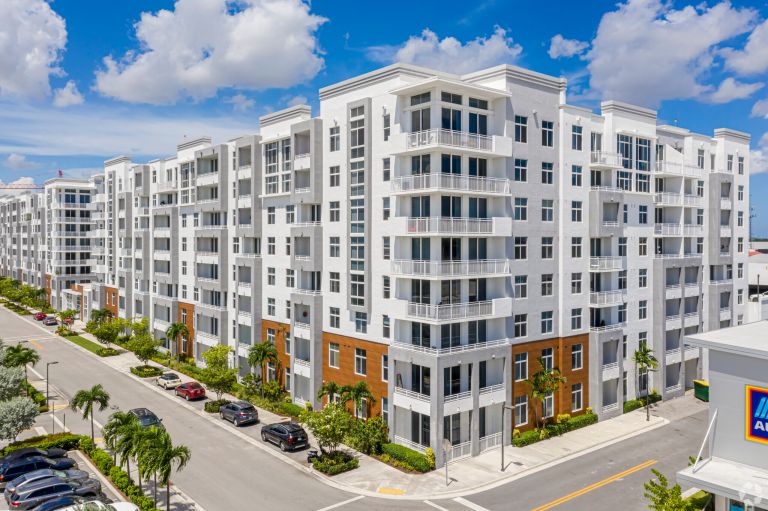Miami-Dade to turn ‘wasted space’ into vibrant neighborhood
A view of the Miami-Dade County Main Library, far left, and the rear of the Miami-Dade County Downtown Motorpool gas station, center, in downtown Miami. The city is looking to transform the area into a vibrant neighborhood with a $10 billion plan. (Matias J. Ocner/Miami Herald via AP)
MIAMI (AP) – In what’s being billed as one of the biggest and most ambitious urban redevelopment schemes in the country, Miami-Dade County has packaged some 17 acres of publicly owned downtown real estate and put it up for bid. The county hopes to lure developers who can deliver on a far-reaching blueprint for a transformed, connected and vital downtown district with thousands of residents and new civic spaces.
It’s no sure thing, however.
The path to development of what the county has branded as MetroCenter will be long – officials say it could take 15 years – and filled with daunting hurdles. The cost of building everything, including 6,000 to 8,500 new apartments and condominiums, could amount to around $10 billion, officials said. They called the estimate “an initial benchmark” that will be refined as project planning advances.
The financing strategy sounds straightforward, but for developers it’s a very big ask: For the opportunity to build large-scale projects on prime land, they would pay Miami-Dade market rent and a small percent of profits, set aside at least a couple of thousand apartments as affordable and workforce housing, and provide required new public buildings like a new main library to the county. The county would reap a windfall of substantial new revenue, including millions in property taxes every year, and get better facilities without tapping taxpayers.
The 17 acres up for grabs are mostly a down-at-the heels hodgepodge consisting of: parking lots and garages; a county gas station and fleet repair shop; cracked, stained sidewalks; scruffy, underused green areas; a couple of outdated county buildings, one so deteriorated that it’s already set to be demolished; and the lightly visited, fortress-like cultural center complex that houses the HistoryMiami museum and the county’s Main Library.
Except for the Clark tower, which would remain in place, the county says everything else can go. That includes the octagonal, UFO-like annex that houses the Miami-Dade commission chambers as well as the cultural center, barely 40 years old and designed by the famed late architect Philip Johnson. Developers would be required to provide new homes for the commission, HistoryMiami and the main library, among other institutions and agencies.
To Miami-Dade Commissioner Eileen Higgins, who has spearheaded the MetroCenter plan, the county’s extensive downtown holdings represent a huge lost opportunity at a time when local real estate is increasingly valuable, the supply of urban land available for development is shrinking, and there’s a desperate shortage of affordable and centrally located places for Miamians to live.
“A lot of it is wasted space,” Higgins, whose district includes the properties to be redeveloped, said in an interview. “This is the people’s land. We should use it to solve the people’s needs.”
The addition of apartments, condos and local public schools, another element of the county plan that developers must provide, would give Miami what it’s always lacked, Higgins said – a true urban neighborhood with full transit options and a panoply of services and amenities where a car is not needed for daily life, but that’s also ideally suited for families. In planning lingo, it’s called a transit-oriented development, or TOD.
“In other cities, you can live in a high-rise district and raise a family. You can’t raise a family in downtown Miami,” Higgins said. “It defeats the purpose of a TOD, if your kids can’t walk to school.”
The financial return for participating developers is potentially huge, something the county is banking on. But so will the unusual and demanding public responsibilities that developers must accept to participate.
Higgins has worked on the plan with Miami-Dade Mayor Daniella Levine Cava and county officials for about two years, consulting with developers and land-use lawyers to make sure the idea is feasible.
“There’s absolutely interest,” Higgins said, referring to developers. “This can be a defining project for a development team. How often do you get to create a neighborhood that’s also the seat of government and the center of transit?”
In the past month, the county has released a draft conceptual brief outlining its plan and some 600 pages of specifications, also in draft form, that developers would have to follow. The guidelines cover everything from housing requirements to infrastructure improvements and a detailed needs list for the library.
It’s now embarking on a two-year effort to identify a master developer who would be tasked with drawing up the MetoCenter master plan, figuring out how to finance it, and overseeing its development under an agreement that would be negotiated with Miami-Dade officials.
The county is gathering public comment on the draft plans and will release a request for proposals from developers by mid-September, said Rita Silva, head of procurement on the project for Miami-Dade.
By the middle of next year, the county hopes to name up to five finalists who would be asked to develop more-specific proposals. The county would then issue a final request for proposals, and the mayor’s office would recommend a winner in 2024, Silva said.
After a detailed agreement is signed, that master developer would then recruit partners to design and build individual projects.
County officials emphasize that nothing is yet set in stone and details are subject to change as plans evolve to ensure their feasibility.
“This is very early stages,” Silva said. “There’s a lot of moving parts.”



